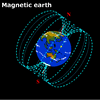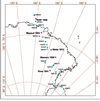The Earth behaves as though it is a large magnet with poles at each end of the axis. At one time it was thought that there was a real magnet inside the Earth, but this is now known not to be the case.
Why does the Earth have a magnetic
field?
 Magnetic fields are generated by moving electrical charges. While
the source of Earth's magnetic field is still under study, it's generally
believed that it arises from motion within the Earth's outer core, which
contains molten iron.
Magnetic fields are generated by moving electrical charges. While
the source of Earth's magnetic field is still under study, it's generally
believed that it arises from motion within the Earth's outer core, which
contains molten iron.
Magnets you use in everyday life have two poles - named the North pole and the South pole. The Earth's magnetic field has poles too. The Earth's magnetic field is tipped in relation to its geographic poles. The field is rather complicated, and there are different possible definitions for the magnetic poles.
 A simple magnetic field that best approximates to the Earth's field
is tilted at about 11° to the Earth's rotational axis. The North and
South magnetic poles are most often referred to as the two points on the
Earth's surface where the Earth's magnetic field points straight up and
down. They are presently located at about 107°W, 80°N (in the Arctic Ocean
north of Canada), and at about 139°E, 64.5°S (off the coast of Antarctica).
A simple magnetic field that best approximates to the Earth's field
is tilted at about 11° to the Earth's rotational axis. The North and
South magnetic poles are most often referred to as the two points on the
Earth's surface where the Earth's magnetic field points straight up and
down. They are presently located at about 107°W, 80°N (in the Arctic Ocean
north of Canada), and at about 139°E, 64.5°S (off the coast of Antarctica).
They also drift. The South Magnetic Pole is currently moving Northwest at about 5 kilometres every year, while the North Magnetic Pole is also moving Northwest, but at about 20 kilometres a year.
Magnetic records in rock samples show not only that the poles move, but many times in the past they have even been totally reversed! That is the North and South poles have swapped places. Since this has not been experienced in modern times, we do not know how this happens or what happens during pole reversal.
Magnetic storms
Earth's magnetic field can be disturbed, particularly by electrically
charged particles from the Sun. The Sun continually sends out charged
particles in the form of bits of atoms known as the solar wind. Sometimes
this wind becomes very strong and creates a great interference with Earth's
magnetic field known as a magnetic storm. One effect of these magnetic
storms is to disrupt radio communication, especially where the radio signal
is bounced from the ionosphere to travel around the Earth's curved surface.
 Another spectacular effect caused by interaction with the solar wind
and the Earth's magnetic field is The Southern Lights, or Aurora Australis
and Northern Lights, Aurora Borealis
Another spectacular effect caused by interaction with the solar wind
and the Earth's magnetic field is The Southern Lights, or Aurora Australis
and Northern Lights, Aurora Borealis
| Copyright owned by the State of Victoria (Department of Education and Early Childhood Development). Used with Permission. |